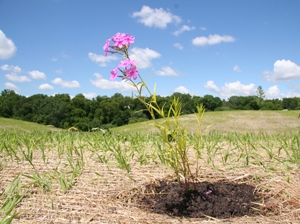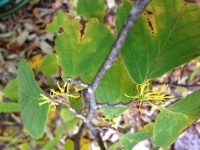

Kim Forbeck
Kim Forbeck, Manager of Land Stewardship, grew up with a love of the outdoors, camping and hiking from the time she could walk. She still spends as much time outdoors as she can mange, with her husband and three boys. Biological and ecological processes have always been a fascination of hers. She has worked in the field of restoration ecology for over 20 years and sees the healing and enhancing of native habitat as one of the most tangible ways to heal the impact humans have on the land.
Improvements on the Oak Leaf Trail
The Oak Leaf Trail is my regular bike commute route from home to work and back. The morning commute is an especially quiet and beautiful experience from the morning a whitetail deer ran alongside me for 50 meters to watching the continuous show of wild geraniums in the spring through scarlet colored sumac in the fall.
A former Chicago-Northwest Railway line, I sometimes imagine what it would have been like to witness those locomotives flying past. In the 1930s, the “400” trains that rumbled along this route were the fastest long-distance passenger trains in the world! The 400 train was named for the route distance of 400 miles between St. Paul, MN and Chicago, IL which it could cover in 400 minutes.
Baby Parks and Plantings
In the spring of each year, all sorts of adorable baby animals can be seen. This spring, I saw baby Great Horned Owls (called owlets), baby White-footed Mice (called pups, pinkies or kittens) and baby Brown Snakes (called snakelets or hatchlings). We don’t usually pay close attention to “baby” plants, but they’re showing up now too!
Native Plant Spotlight: American Witch-hazel (Hamamelis virginiana)
What an odd name… witch-hazel. What does it mean? Well, some folks think the leaves look similar to the hazelnut shrub’s leaves, hence the “hazel” portion of the name. But, why “witch”? There are several possibilities. The pliable branches of the witch-hazel have been used as divining rods to search for water, also called water witching. Or it could be for the Old English “wych” which means pliable, as in the English wych elm with its bendable branches. My favorite explanation is this: When witch-hazel seeds mature in the fall they explode out of the fruit in distances of up to 25 feet away! When people would walk through the woods in the fall, they would be startled by the sound of the recently exploded witch-hazel seeds hitting the ground or the leaves of nearby bushes, so they started calling those shrubs “witch hazels” (soucrce: Bedford Audubon Society).
Copyright © 2023 The Urban Ecology Center





